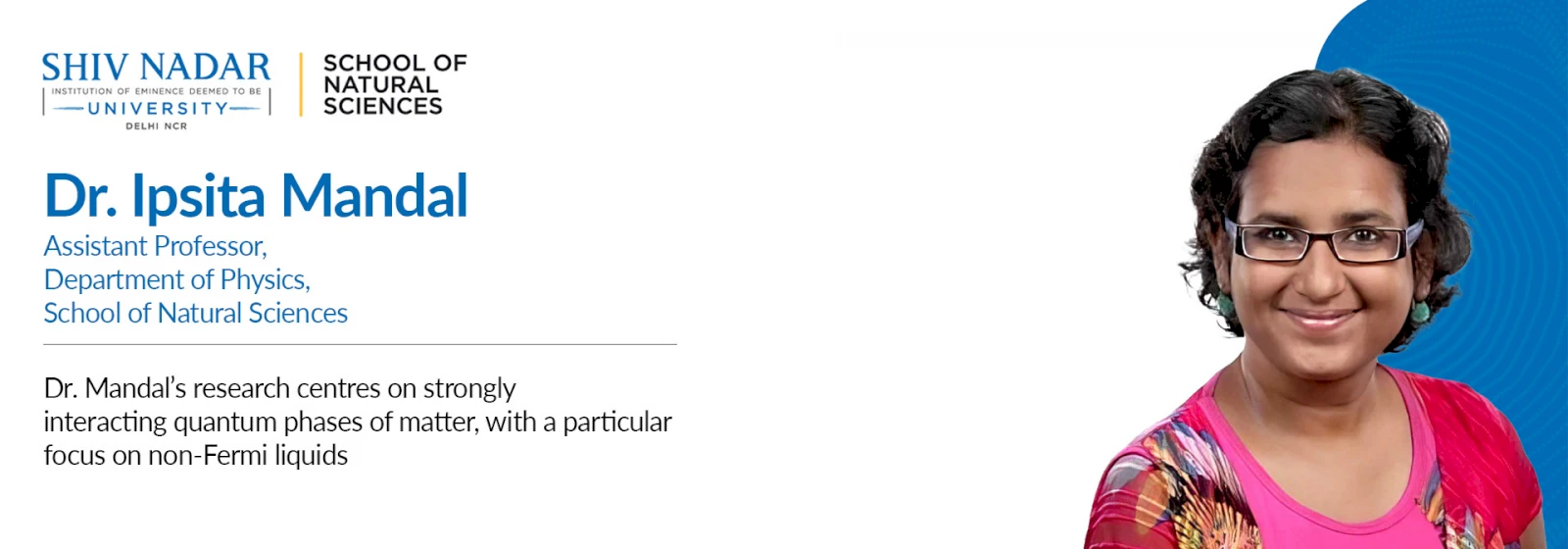Strangely Irresistible: Deciphering the Behaviour of ‘Strange Metals’
Superconductivity—the phenomenon where a material’s electrical resistance drops to nearly zero at extremely low temperatures—has long fascinated scientists. Achieving superconductivity at room temperature is often regarded as the Holy Grail of condensed matter physics. This breakthrough would revolutionise technology as we know it, leading to advances in various fields such as quantum computing, high-efficiency power grids, and next-generation medical devices. At the Department of Physics, Shiv Nadar Institution of Eminence, Dr. Ipsita Mandal is meticulously paving the next slab on the road to room-temperature superconductivity.
Dr. Mandal’s work deals with elucidating the theoretical framework underlying the behaviour of ‘strongly interacting systems.’ Typically, the properties of a metal can be understood by the behaviour of individual particles present in its bulk, such as electrons. But that is not always the case. “When you take a large number of particles, which are somehow cooperating and interacting with each other, the result is that you get some ‘emergent’ phenomena, which you would not get if you took just one particle,” says Dr. Mandal. Emergent phenomena refer to events or behaviours that particles do not display on their own, but that manifest only when particles interact with each other. Superconductivity is one such emergent phenomenon.
While Dr. Mandal’s research doesn’t directly target superconductivity, her work has significant implications for understanding ‘strange metals.’ Strange metals, or ‘type-2’ superconductors, are those metals in which electrical resistance varies in direct proportion to their temperature. This is atypical for metals, where resistance is commonly proportional to the square of the temperature. This means that for a temperature of 25K, a strange metal would offer 25 times lower electrical resistance than a conventional metal. As a result, these strange metals are the more viable candidate for realising room-temperature superconductivity.
Strange metals are also referred to as ‘non-Fermi liquids’ because their behaviour defies traditional Fermi liquid theory, which has long been used to describe the behaviour of weakly interacting electrons in metals. Among Dr. Mandal’s major contributions to the field of non-Fermi liquid theory is the development of a mathematical framework to describe their dynamics. Across a series of papers, she has teased out many of the pressing questions in non-Fermi liquid theory, including how non-Fermi liquid nature arises from a system’s scaling properties (which vary based on the system’s size/scale) at quantum phase transition—which is the phase of matter at absolute zero temperature. Another example of Dr. Mandal’s achievements in the field is her mathematical description of transport properties—such as electrical conductivity, thermal conductivity, and diffusion—in typical non-Fermi liquids.
Dr. Mandal has won numerous awards for her work on in quantum condensed matter theory, including the 2022 Polish Prime Minister’s Prize, which was awarded for her Habilitation thesis. Furthermore, she has been selected for numerous fellowships, such as the International Centre for Theoretical Physics (ICTP) Associate Fellowship, a Nordic Institute for Theoretical Physics (Nordita) Fellowship, and the Ramanujan Fellowship from the Science and Engineering Research Board (SERB) India. Dr. Mandal has also been chosen for the prestigious Marie Skłodowska-Curie FRIAS COFUND Senior Fellowship at the Freiburg Institute for Advanced Studies (FRIAS) as a part of the 2023–24 competition.
Beyond strange metals, Dr. Mandal is also cutting a swathe through the theory of non-Hermitian systems. Conventional condensed matter deals with Hermitian systems. These can be described using real eigenvalues (a set of characteristic values that are used to describe the physical properties of a system), which can be measured. “But what if the eigenvalues are complex? We can’t measure complex quantities. That is non-Hermiticity,” explains Dr. Mandal. Although non-Hermitian systems have been a focus in photonics for years, they’ve only recently gained traction in condensed matter physics. Untangling the theory of non-Hermitian systems could lead to the development of more sensitive sensors, among other applications.
Beyond the focus areas mentioned above, Dr. Mandal works on a number of other problems in physics, including numerous collaborations on weakly interacting systems, semimetals, and topology in transport properties.
As she continues to tackle some of the most challenging questions in condensed matter physics, we eagerly await the next chapter of her remarkable contributions!
